9 Best Herbal Teas For Diarrhea
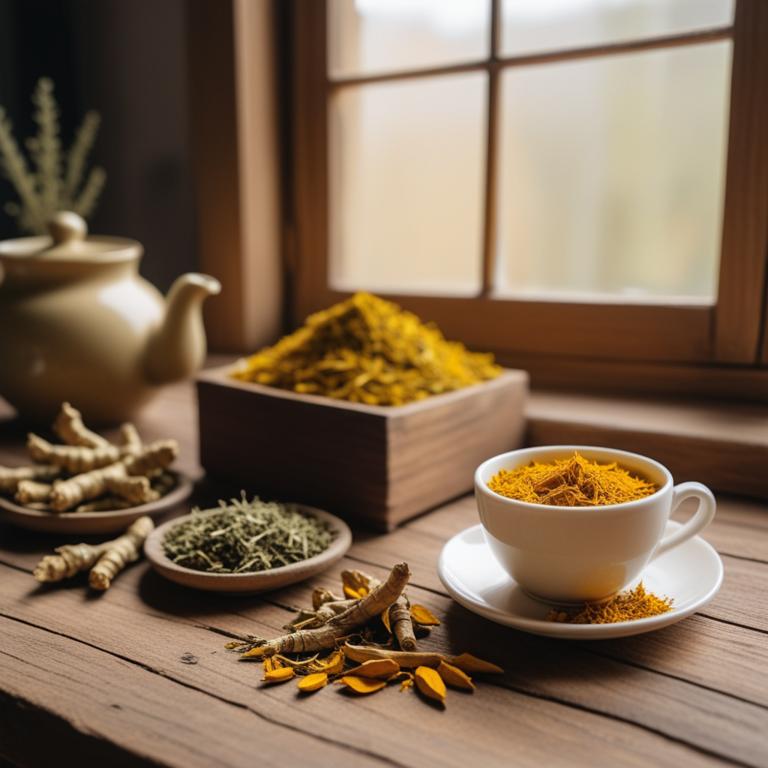
Herbal teas for diarrhea are a type of natural remedy that involves brewing leaves, flowers, roots, or fruits to create a medicinal tea that helps alleviate symptoms of diarrhea.
These teas can be effective in treating diarrhea due to their antimicrobial, anti-inflammatory, and soothing properties that help calm the digestive system.
Examples of herbal teas that can be used to treat diarrhea include peppermint tea, which helps relax the muscles in the digestive tract and reduce inflammation; ginger tea, which has anti-inflammatory properties that can help alleviate stomach discomfort and nausea; chamomile tea, which soothes the digestive system and promotes relaxation; fennel tea, which helps calm the digestive tract and reduce gas and bloating; and licorice root tea, which has anti-inflammatory properties that can help soothe the stomach and reduce symptoms of diarrhea.
By incorporating these herbal teas into one's diet, individuals can find relief from the discomfort and urgency associated with diarrhea.
Related Study
According to "Journal of evidence-based complementary & alternative medicine", teas for diarrhea, specifically black tea, have been found to have an antidiarrheal effect, as demonstrated by a significant decrease in the number of defecations per 24 hours and an increase in the proportion of patients with formed stool in a clinical trial study.
Below there's a list of the 9 best herbal teas for diarrhea.
Table of Contents
Also, you may be interested in...
Today Free Bonus!
The Ultimate Herb Drying Checklist
(For Long-Lasting Powerful Medicinal Effect)
How to easily dry herbs that don't mold and that keep their strong medicinal power for more than 1 year.
1. Zingiber officinale teas

Zingiber officinale teas, also known as ginger teas, have been used traditionally to treat diarrhea due to their antispasmodic, anti-inflammatory, and carminative properties.
The bioactive constituents of ginger, including gingerols and shogaols, help to reduce inflammation and alleviate gastrointestinal spasms, thereby providing relief from diarrhea.
The anti-inflammatory properties of ginger teas also help to soothe the digestive tract, reducing the frequency and severity of diarrhea episodes.
By utilizing the beneficial properties of Zingiber officinale teas, individuals can experience relief from diarrhea and enjoy the additional benefits of improved digestion and reduced nausea.
Related Study
According to the study, Zingiber officinale teas for diarrhea contain gingerol as a main antidiarrheal component which helps relieve chemotherapy-induced diarrhea through different mechanisms.
Recipe:
- Gather 1 tablespoon of fresh Ginger root and 1 cup of boiling water.
- Peel the Ginger root and chop it into small pieces.
- Add the chopped Ginger to the boiling water and let it steep for 5-7 minutes.
- Strain the tea into a cup and discard the Ginger pieces.
- Drink the tea 2-3 times a day as needed to help relieve diarrhea symptoms.
Zingiber officinale teas can be effective in treating diarrhea, but possible side effects include nausea, stomach pain, and dizziness due to its active compounds like gingerols and shogaols.
To use Zingiber officinale teas safely, it is recommended to start with a small dose and gradually increase as needed, and to avoid taking it with other medications or substances that may interact with its active compounds, such as antacids, blood thinners, or diabetes medications.
Zingiber Officinale Tea on Amazon
FGO Organic Ginger Tea, 100 Count, Eco-Conscious Tea Bags, Caffeine Free, Packaging May Vary (Pack of 1)
Disclaimer: We earn a commission if you click this link and make a purchase at no additional cost to you.
2. Glycyrrhiza glabra teas

Glycyrrhiza glabra teas, also known as licorice root tea, have been traditionally used to treat diarrhea due to its anti-inflammatory and antispasmodic properties.
This herbal preparation helps to treat diarrhea by soothing the stomach and intestinal linings, reducing inflammation and alleviating cramping and spasms associated with the condition.
The bioactive constituents of Glycyrrhiza glabra, including glycyrrhizin and flavonoids, help to treat diarrhea by inhibiting the growth of pathogenic bacteria and reducing inflammation in the gut.
The benefits of using Glycyrrhiza glabra teas to treat diarrhea include its ability to quickly alleviate symptoms, promote gut health, and provide relief from abdominal cramps and discomfort.
Recipe:
- Gather 1 cup of fresh or dried Glycyrrhiza glabra roots. If using dried roots, crush them into small pieces.
- Measure 2-3 tablespoons of the crushed roots and place them in a cup.
- Boil 1 cup of water in a kettle or pot.
- Pour the boiling water over the roots in the cup and let it steep for 5-7 minutes.
- Strain the liquid and discard the roots. Drink the tea 2-3 times a day to help manage diarrhea.
Glycyrrhiza glabra teas can be used to treat diarrhea, but it may cause side effects such as increased blood pressure, potassium deficiency, and irregular heartbeats, especially in people with pre-existing heart conditions.
To use these teas safely, individuals should be cautious of their body's response and monitor their blood pressure and potassium levels regularly, as well as avoid taking them for extended periods and in large quantities.
Glycyrrhiza Glabra Tea on Amazon
Pukka Herbal Teas Licorice and Cinnamon - 20 Bags, 20 Count
Disclaimer: We earn a commission if you click this link and make a purchase at no additional cost to you.
3. Curcuma longa teas
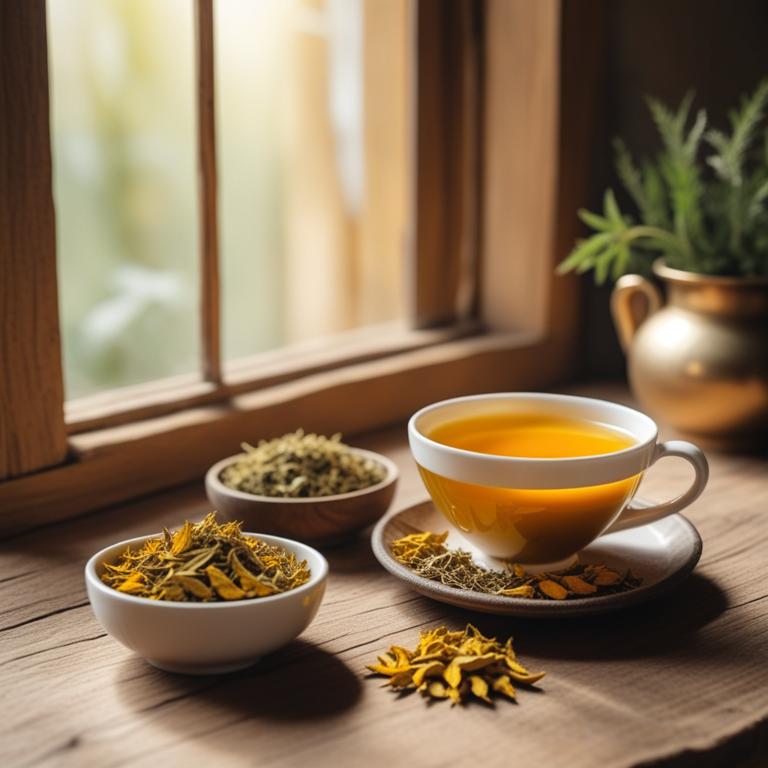
Curcuma longa teas, derived from the rhizomes of the Curcuma longa plant, have been traditionally used to treat diarrhea due to their anti-inflammatory, antispasmodic, and antimicrobial properties.
These properties help to reduce inflammation in the gastrointestinal tract, alleviate spasms that can lead to diarrhea, and eliminate the underlying bacterial or viral infections that cause the ailment.
The bioactive constituents of Curcuma longa teas, including curcumin, demethoxycurcumin, and bisdemethoxycurcumin, have been identified as key compounds responsible for their therapeutic effects, which help to reduce gut motility, inhibit the growth of pathogenic microorganisms, and modulate the gut microbiome.
The benefits of using Curcuma longa teas to treat diarrhea include rapid relief from symptoms, prevention of dehydration, and promotion of a healthy gut microbiome, making it a valuable herbal remedy for managing this common gastrointestinal disorder.
Related Study
According to "Biological trace element research", Curcuma longa teas for diarrhea may be effective due to their high concentration of antioxidants and inhibitory action against most bacterial strains, which can help in treating gastrointestinal infections.
Recipe:
- Gather 1 teaspoon of dried turmeric root (Curcuma longa) and 1 cup of boiling water.
- Add the turmeric root to the boiling water and let it steep for 5-7 minutes.
- Strain the mixture into a cup using a fine-mesh sieve or cheesecloth.
- Add 1 tablespoon of honey to the turmeric tea, if desired, and stir well.
- Drink the turmeric tea 2-3 times a day, or as needed, to help alleviate diarrhea symptoms.
Curcuma longa teas can be effective in treating diarrhea due to its anti-inflammatory and antimicrobial properties, but possible side effects may include stomach upset, nausea, and digestive discomfort.
To minimize these risks, it is essential to start with small doses and gradually increase the amount, as well as to avoid taking the tea on an empty stomach and to drink plenty of water to stay hydrated.
Curcuma Longa Tea on Amazon
Pure Ceylon Turmeric Brew - 100% Organic Ceylon Turmeric Tea Bags (40 Sachets - pack of 2 – 20 COUNT PER BOX)
Disclaimer: We earn a commission if you click this link and make a purchase at no additional cost to you.
4. Cinchona officinalis teas
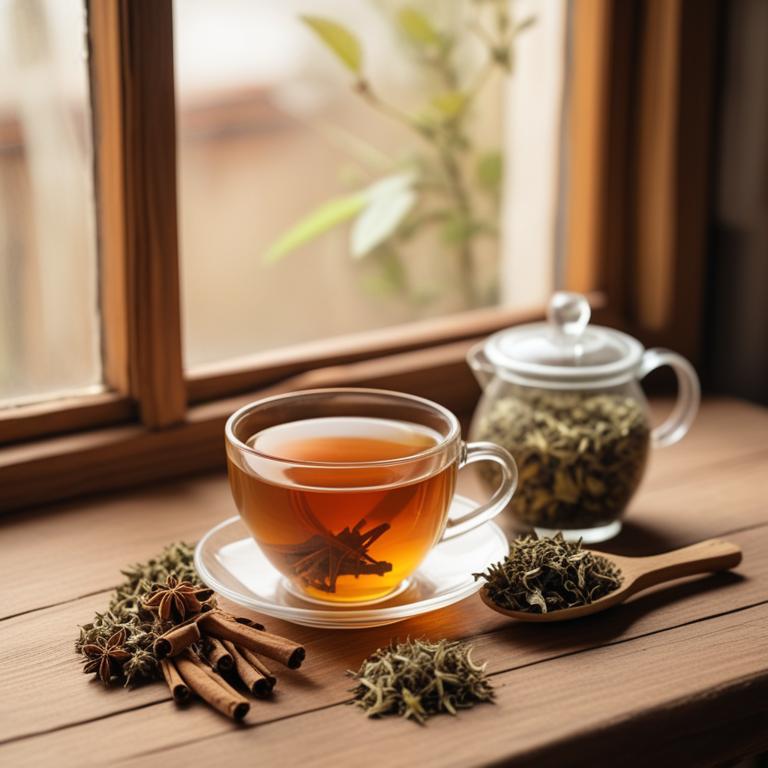
Cinchona officinalis teas, a traditional herbal remedy, have been used to treat diarrhea due to their anti-inflammatory, antimicrobial, and astringent properties.
The quinine and other bioactive constituents present in Cinchona officinalis teas help to reduce inflammation and alleviate symptoms associated with diarrhea, such as cramping and diarrhea.
By acting as a natural antiperistaltic agent, Cinchona officinalis teas slow down gut contractions, allowing the body to reabsorb fluids and electrolytes, thereby reducing the frequency and severity of diarrhea.
The benefits of using Cinchona officinalis teas to treat diarrhea include a reduction in symptoms, faster recovery, and the avoidance of harsh pharmaceutical side effects.
Recipe:
- Gather 1 cup of boiling water and 1/4 teaspoon of dried Cinchona officinalis bark.
- Let the bark steep in the boiling water for 5-7 minutes.
- Strain the mixture into a cup to remove the bark.
- Add honey to taste, if desired.
- Drink the tea 2-3 times a day to help manage diarrhea.
Cinchona officinalis teas can be used to treat diarrhea, but it may cause side effects such as stomach cramps, nausea, and vomiting due to its high quinine content.
To use Cinchona officinalis teas safely, it is recommended to start with a low dose and gradually increase as needed, and to avoid consuming it for extended periods to minimize potential interactions with other medications and to reduce the risk of quinine toxicity.
Cinchona Officinalis Tea on Amazon
Quina Roja(chinona) & Palo de Víbora Tea – 100% Natural, Vegan, Hecho en México | 25 Tea Bags
Disclaimer: We earn a commission if you click this link and make a purchase at no additional cost to you.
5. Foeniculum vulgare teas
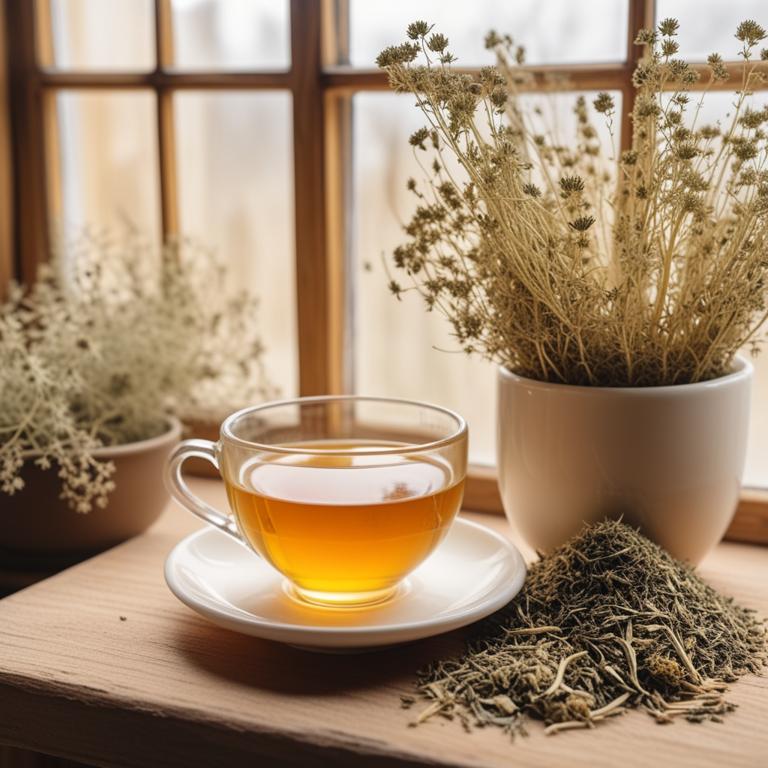
Foeniculum vulgare teas, also known as fennel tea, have been traditionally used to treat diarrhea due to their soothing and anti-inflammatory properties.
The bioactive constituents, such as anethole and fenchone, help to relax the muscles in the digestive tract, reducing spasms and cramping, which can contribute to diarrhea.
By reducing inflammation and promoting digestive regularity, fennel tea helps to alleviate symptoms of diarrhea, such as abdominal pain and loose stools.
The benefits of using fennel tea to treat diarrhea include reduced frequency and severity of episodes, improved digestive health, and a decreased risk of dehydration.
Related Study
According to the given study, there is no specific information about Foeniculum vulgare teas for diarrhea, however, Foeniculum vulgare is mentioned as one of the medicinal plants with antispasmodic activity, which could be beneficial in treating gastrointestinal diseases including diarrhea.
Recipe:
- Gather 1 cup of fresh Foeniculum vulgare leaves and flowers, or 1 teaspoon of dried Foeniculum vulgare.
- Bring 1 cup of water to a boil in a pot.
- Add the Foeniculum vulgare to the boiling water and reduce heat.
- Steep the mixture for 5-7 minutes, then strain it into a cup.
- Drink the tea 2-3 times a day to help manage diarrhea.
Foeniculum vulgare teas can be used to treat diarrhea, but it may cause side effects such as stomach upset, nausea, and allergic reactions in some individuals.
To use Foeniculum vulgare teas safely, precautions include taking small amounts initially to test tolerance, avoiding consumption if pregnant or breastfeeding, and not mixing it with other medications or herbal preparations.
Foeniculum Vulgare Tea on Amazon
Fennel Tea - 100% Organic and Alkaline - 15 Unbleached/Chemical-Free Fennel Tea Bags - Caffeine-Free, No GMO
Disclaimer: We earn a commission if you click this link and make a purchase at no additional cost to you.
6. Aloe barbadensis teas
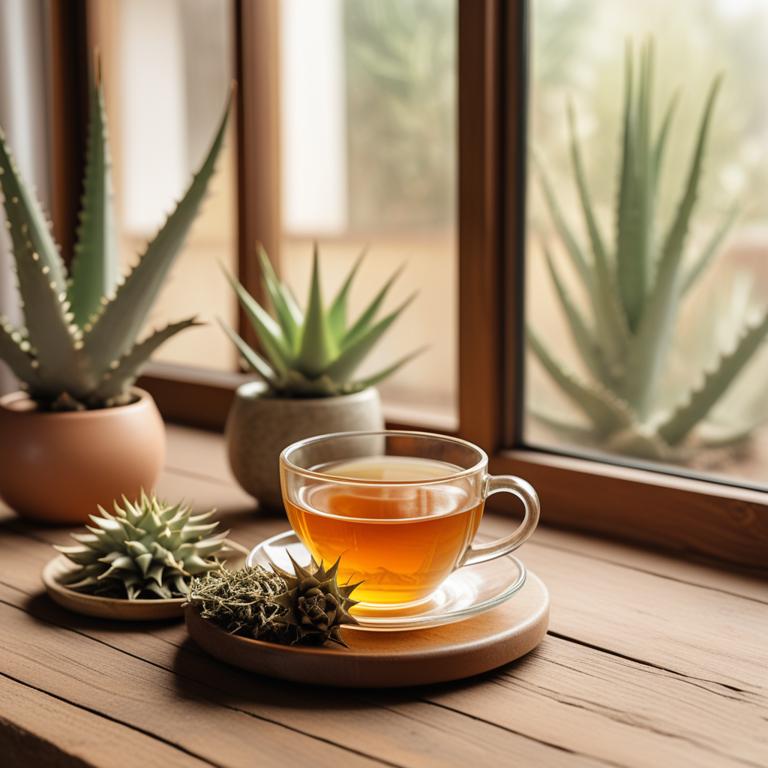
Aloe barbadensis teas have been traditionally used to treat diarrhea due to their anti-inflammatory and soothing properties.
The herbal preparation helps to treat this ailment by reducing inflammation in the digestive tract, calming the gut, and promoting the growth of beneficial gut bacteria.
The bioactive constituents of Aloe barbadensis teas, including aloin and aloe-emodin, have been shown to have antimicrobial and anti-inflammatory effects, which contribute to its therapeutic benefits.
The benefits of using Aloe barbadensis teas to treat diarrhea include reduced symptoms, improved gut health, and a faster recovery time.
Recipe:
- Wash your hands and aloe plant leaves with soap and water.
- Cut 2-3 aloe leaves from the plant and remove the thick outer skin.
- Cut the inner gel into small pieces and place them in a bowl.
- Add 1 cup of boiling water to the bowl and let it steep for 10-15 minutes.
- Strain the liquid and drink 1 cup of aloe tea 2-3 times a day to help with diarrhea.
Aloe barbadensis teas can cause stomach upset, nausea, and vomiting in some individuals, especially when consumed in excess, due to its potential to exacerbate the digestive issues associated with diarrhea.
Precautions should be taken to avoid interactions with other medications, as well as to monitor for signs of dehydration, such as excessive thirst or dark urine, when using Aloe barbadensis teas to treat diarrhea, especially in people with underlying health conditions.
Aloe Barbadensis Tea on Amazon
The Republic of Tea Beautifying Botanicals® Clean Beauty Berry Aloe Herbal Tea Bags (36 count)
Disclaimer: We earn a commission if you click this link and make a purchase at no additional cost to you.
7. Mentha x piperita teas
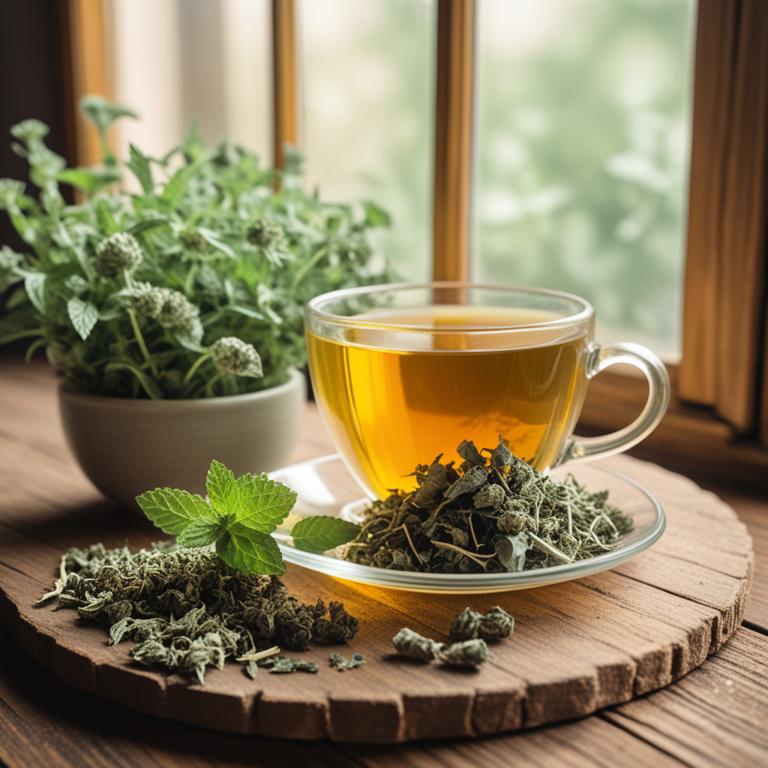
Mentha x piperita teas, also known as peppermint teas, have been traditionally used to treat diarrhea due to their anti-inflammatory and antispasmodic properties.
The bioactive constituents of peppermint, including menthol and menthone, help to ease digestive discomfort and reduce symptoms of diarrhea by relaxing the muscles in the digestive tract and reducing inflammation.
By promoting the relaxation of the intestinal muscles and reducing spasms, peppermint teas can help to alleviate diarrhea and provide relief from its symptoms.
The benefits of using peppermint teas to treat diarrhea include reduced symptoms, improved digestion, and a decrease in the frequency and severity of diarrhea episodes.
Related Study
According to "BMC veterinary research", Mentha x piperita teas for diarrhea were found to be one of the most promising candidates for the prevention and treatment of gastrointestinal diseases in calves and piglets.
Recipe:
- Gather 1/4 cup of fresh mint leaves (Mentha x piperita) or 1 teaspoon of dried mint leaves.
- Boil 1 cup of water in a pot.
- Remove the pot from heat and add the fresh or dried mint leaves.
- Steep for 5-7 minutes, then strain the liquid using a tea strainer or cheesecloth.
- Drink the tea 2-3 times a day to help with diarrhea symptoms.
Mentha x piperita teas can be effective in treating diarrhea, but it may also cause side effects such as stomach upset, nausea, and allergic reactions in some individuals.
To use Mentha x piperita teas safely, it's recommended to start with a low dose, monitor your body's response, and avoid consuming it if you experience any severe symptoms or if you have a history of stomach problems or allergies.
8. Taraxacum officinale teas
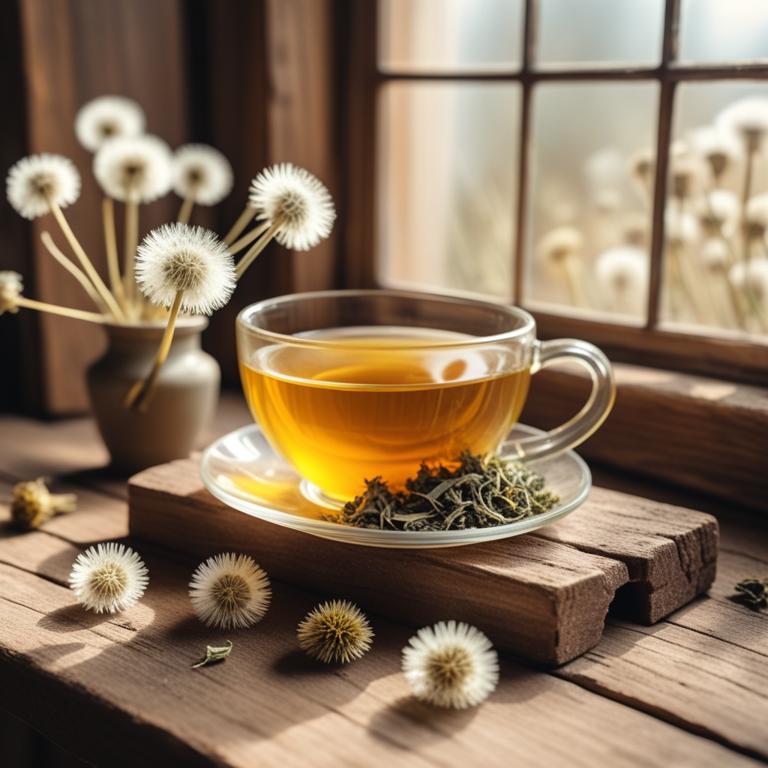
Taraxacum officinale teas, also known as dandelion root tea, have been traditionally used to treat diarrhea due to their anti-inflammatory and antimicrobial properties.
The bioactive constituents, including flavonoids, phenolic acids, and sesquiterpenes, help to regulate bowel movements and alleviate symptoms of diarrhea.
By reducing inflammation in the digestive tract and promoting the growth of beneficial gut bacteria, Taraxacum officinale teas help to treat diarrhea by restoring balance to the gut microbiome.
The benefits of using Taraxacum officinale teas to treat diarrhea include reduced frequency and severity of episodes, improved overall gut health, and a lower risk of dehydration and other complications associated with chronic diarrhea.
Recipe:
- Gather 1 cup of fresh Taraxacum officinale leaves and flowers, or 2 tablespoons of dried leaves and flowers.
- Add 1 cup of boiling water to the leaves and flowers in a pot.
- Let it steep for 5-7 minutes, then strain the liquid into a cup.
- Add 1 tablespoon of honey to the tea, if desired, and stir well.
- Drink the tea 2-3 times a day to help relieve diarrhea.
Taraxacum officinale teas can cause stomach upset, nausea, and vomiting in some individuals due to its emetic properties, which may worsen diarrhea in severe cases.
When using Taraxacum officinale teas to treat diarrhea, it is essential to start with a low dose and gradually increase as needed, and also to avoid consuming it for extended periods, as prolonged use may lead to potassium and electrolyte imbalances.
Taraxacum Officinale Tea on Amazon
Teeccino Dandelion Coconut Tea - Caffeine Free, Roasted Herbal Tea with Prebiotics, 3x More Herbs than Regular Tea Bags, Gluten Free - 25 Tea Bags
Disclaimer: We earn a commission if you click this link and make a purchase at no additional cost to you.
9. Cassia auriculata teas
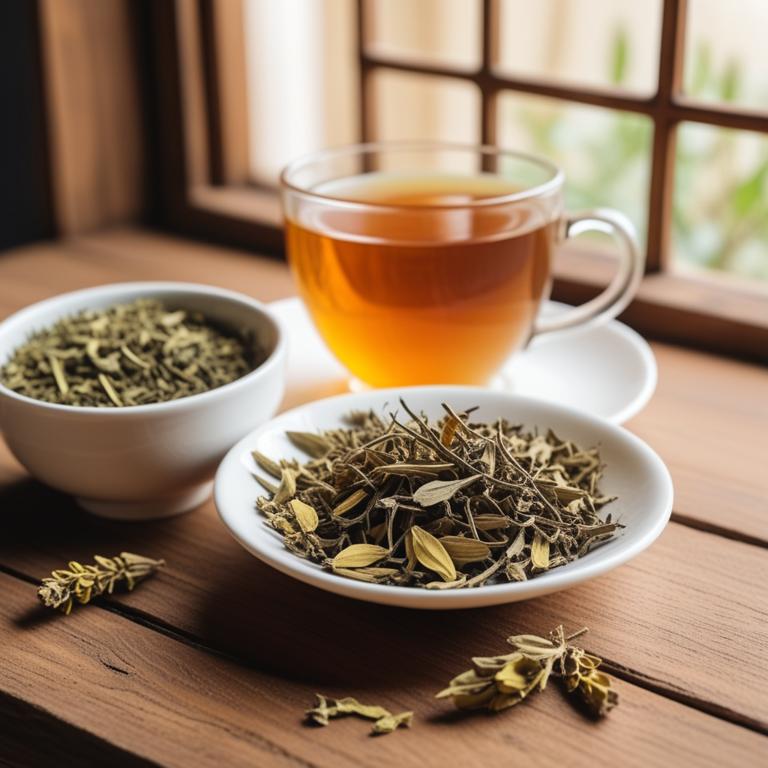
Cassia auriculata teas have been traditionally used to treat diarrhea due to their anti-inflammatory, antimicrobial, and antioxidant properties.
The bioactive constituents present in this herbal preparation, including flavonoids, phenolic acids, and terpenoids, help to inhibit the growth of pathogens and reduce inflammation in the gastrointestinal tract, thus alleviating diarrhea symptoms.
The antimicrobial properties of Cassia auriculata teas help to eliminate the causative agents of diarrhea, such as bacteria, viruses, and fungi, which contribute to the development of this ailment.
Regular consumption of Cassia auriculata teas has been found to provide relief from diarrhea and also has benefits such as reducing oxidative stress, improving gut health, and promoting overall well-being.
Related Study
According to "Journal of ethnopharmacology", Cassia auriculata teas for diarrhea have been historically used to alleviate symptoms of diarrhea, although the study does not specifically mention the tea's effectiveness in treating the condition.
Recipe:
- Gather 1 cup of Cassia auriculata leaves. You can buy this at a local herbal store or online.
- Boil 1 cup of water in a pot and remove from heat.
- Add 2 tablespoons of Cassia auriculata leaves to the boiled water. Let it steep for 5-7 minutes.
- Strain the tea using a fine-mesh sieve or cheesecloth. Discard the leaves.
- Drink the tea warm, 2-3 times a day. You can add honey or lemon to taste.
Cassia auriculata teas can be effective in treating diarrhea, but using them for an extended period may cause gastrointestinal side effects such as abdominal pain, nausea, and vomiting.
Precautions should be taken to avoid excessive consumption, as it can also cause allergic reactions, interact with other medications, and exacerbate conditions like kidney stones.